Did you know there are many exciting animals that start with the letter T? From tigers and tapirs to tarantulas and tamarins, the world of T animals is diverse and captivating. This guide will explore some of these incredible creatures, their habitats, and unique characteristics.
Key Takeaways:
- Tamarins are small monkeys with distinctive features such as mustaches and colored hands and feet.
- Tanagers are brightly-colored birds known for their feeding habits and vibrant plumage.
- The Tapanuli Orangutan is a critically endangered species found in Sumatra, closely related to Bornean orangutans.
- Tapirs are large, pig-like animals with flexible noses and are found in various parts of the world.
- Tiger beetles are predatory insects known for their high-speed pursuit of prey.
Tamarin
Tamarins are small monkeys found in Central and South America. They live in tropical rainforests and belong to the genus Saguinus. Some well-known species include the emperor tamarin, distinguished by its gray-black coat and large white mustache, and the red-handed tamarin, recognized by its golden-orange hands and feet.
Tamarins are fascinating creatures known for their unique physical features and social behaviors. Let’s take a closer look at some of the different tamarin species:
| Tamarin Species | Physical Description | Native Range |
|---|---|---|
| Emperor Tamarin | Gray-black coat with a large white mustache | Amazon rainforest in Brazil, Peru, and Bolivia |
| Red-handed Tamarin | Golden-orange hands and feet | Coastal regions of northeastern Brazil |
Tamarins are highly social animals that live in tight-knit family groups. These groups consist of a dominant breeding pair and their offspring. They communicate through a range of vocalizations and display unique cooperative behaviors, such as carrying and sharing food among group members.
Tamarins are not only visually stunning, but their complex social dynamics and intelligence make them truly captivating creatures. They are a prime example of the incredible diversity found in the primate world.
These remarkable primates play an essential role in maintaining the balance of their rainforest habitats by dispersing seeds and controlling insect populations. However, tamarin populations are threatened by habitat loss due to deforestation and illegal pet trade activities.
- Tamarins have a diet consisting of fruits, tree sap, insects, and small vertebrates.
- They have long, flexible fingers and sharp claws, enabling them to easily grasp trees and navigate their forest homes.
- Their small size allows them to move swiftly through the dense undergrowth of the rainforest canopy.
- Tamarins have a unique dental formula, with specialized teeth for tearing open the bark of trees to access plant exudates.
By raising awareness about these incredible creatures and supporting conservation efforts, we can help protect and preserve tamarins and their fragile rainforest ecosystems for future generations.
Tanager
Tanagers are small birds found in the Americas, with around 240 species in the bird family Thraupidae. They are known for their vibrant plumage, making them a delight to observe in the wild. These colorful birds come in a variety of shades including red, orange, and yellow, adding a vibrant touch to their natural surroundings. Tanagers are a diverse group, each species displaying unique characteristics and behaviors.
One example of a tanager species is the Scarlet-Rumped Tanager, known for its striking red plumage and contrasting black wings. This species is found in the tropical rainforests of Brazil, Bolivia, and Peru. The Scarlet-Rumped Tanager is a social bird and is often seen foraging in small groups. Its diet consists of a combination of seeds, fruit, nectar, and insects. This flexibility in feeding habits allows the Scarlet-Rumped Tanager to adapt to different food sources depending on its habitat.
The Thraupidae family, to which tanagers belong, is diverse in terms of habitat and behavior. Some species are arboreal, spending most of their time in trees, while others are ground dwellers. Their diet also varies, with some species primarily feeding on fruits and others specializing in insect hunting. Tanagers play a vital role in seed dispersal and pollination, contributing to the health and diversity of their ecosystems.

Tapanuli Orangutan
The Tapanuli orangutan, scientifically known as Pongo tapanuliensis, is a critically endangered species of orangutan found in an isolated part of Sumatra Island. This remarkable primate was recognized as a separate species in 2017, making it one of three orangutan species known to exist.
With a population of only approximately 800 individuals, the Tapanuli orangutan is facing the threat of extinction. The critically endangered status of this species is attributed to habitat loss, illegal hunting, and other human activities that have drastically reduced their numbers.
Recent DNA analysis has also revealed an intriguing connection between the Tapanuli orangutan and Bornean orangutans. Previously, it was believed that their genetic similarity to Sumatran orangutans was higher. However, the analysis showed that they share a closer genetic relationship with Bornean orangutans.

Conservation Efforts
Conservation organizations and local communities are working together to protect the Tapanuli orangutan and its habitat. Efforts include establishing protected areas, implementing stricter law enforcement against illegal activities, and promoting sustainable practices.
The Tapanuli orangutan serves as a flagship species for the conservation of Sumatra’s forests, biodiversity, and the well-being of local communities. Conserving this unique primate not only ensures the survival of an endangered species but also helps to safeguard the delicate balance of the ecosystem it inhabits.
Tapir
Tapirs are fascinating, pig-like animals known for their distinctive appearance and unique features. With their flexible, prehensile noses, they are easily recognizable in the animal kingdom. There are five different species of tapirs, each with its own characteristics and habitats.
Brazilian Tapir
The Brazilian tapir, also known as the South American Tapir, is the largest land mammal in the Amazon Rainforest. With its sleek black coat and rounded body, it is a majestic creature that plays a crucial role in maintaining the ecosystem. The Brazilian tapir is a herbivore, feeding on vegetation and fruits found in its habitat.
Malayan Tapir
The Malayan tapir is a unique creature with its distinct black and white coat pattern. It is the largest of all tapir species and is native to the rainforests of Southeast Asia. The Malayan tapir is a solitary animal and has a herbivorous diet, primarily consisting of leaves, aquatic plants, and fruits.
Baird’s Tapir
Baird’s tapir, also known as the Central American tapir, is found in the rainforests and mountainous regions of Central and South America. It has a dark brown or black coat, with a white or cream-colored marking on its face and throat. Baird’s tapir is an excellent swimmer and often takes refuge in water bodies to escape predators.
Kabomani Tapir
The kabomani tapir, also known as the little black tapir, is one of the smallest tapir species. It is found in the dense forests of Brazil and is distinguished by its deep black color and small stature. The kabomani tapir is a herbivore, foraging on a variety of plant matter to meet its dietary needs.
Mountain Tapir
The mountain tapir, also known as the woolly tapir, is a critically endangered species found in the cloud forests of the Andes. It has a shaggy, thick coat that helps it thrive in the cold, high-altitude regions. The mountain tapir is an important seed disperser, contributing to the maintenance of the cloud forest ecosystem.
These remarkable creatures are essential for the health and balance of their respective habitats. Understanding and conserving tapir populations is crucial for the preservation of biodiversity and the protection of these magnificent animals.

Tarantula
Tarantulas, belonging to the family Theraphosidae, are large, hairy spiders found on every continent. With approximately 900 species of tarantulas, they exhibit a wide range of sizes and characteristics. While some tarantulas have a painful bite, it is important to note that their bites are not deadly.
“Tarantulas are fascinating creatures, known for their impressive size and striking appearance. Despite their intimidating nature, many tarantulas make fascinating pets and are kept in homes as exotic pets,” says Dr. Robert Davis, an arachnid expert.
One of the well-known species of tarantula is the Mexican Redknee Tarantula. As the name suggests, this tarantula species features a distinctive red patch on its knees, making it easily recognizable. With its colorful appearance and docile temperament, the Mexican Redknee Tarantula is a popular choice among tarantula enthusiasts.
Benefits of Keeping Tarantulas as Pets
- Low Maintenance: Tarantulas require minimal care, making them suitable for beginners and busy individuals.
- Fascinating Behaviors: Observing the unique behaviors of tarantulas, such as web-spinning and molting, can provide hours of entertainment.
- Education: Keeping tarantulas as pets can educate and raise awareness about these often-misunderstood creatures.
- Therapeutic: Many individuals find the presence of tarantulas to be calming and therapeutic.
Common Misconceptions about Tarantulas
| Misconception | Fact |
|---|---|
| Tarantulas are aggressive and dangerous. | Most tarantulas are docile and only bite when provoked. |
| All tarantulas are large. | Tarantula sizes vary greatly, with some species being smaller than a human thumbnail. |
| Tarantulas are deadly venomous. | While tarantula venom can cause discomfort, it is not lethal to humans. |
| Tarantulas are prone to escape. | With proper enclosure setup and care, the risk of escape is minimal. |
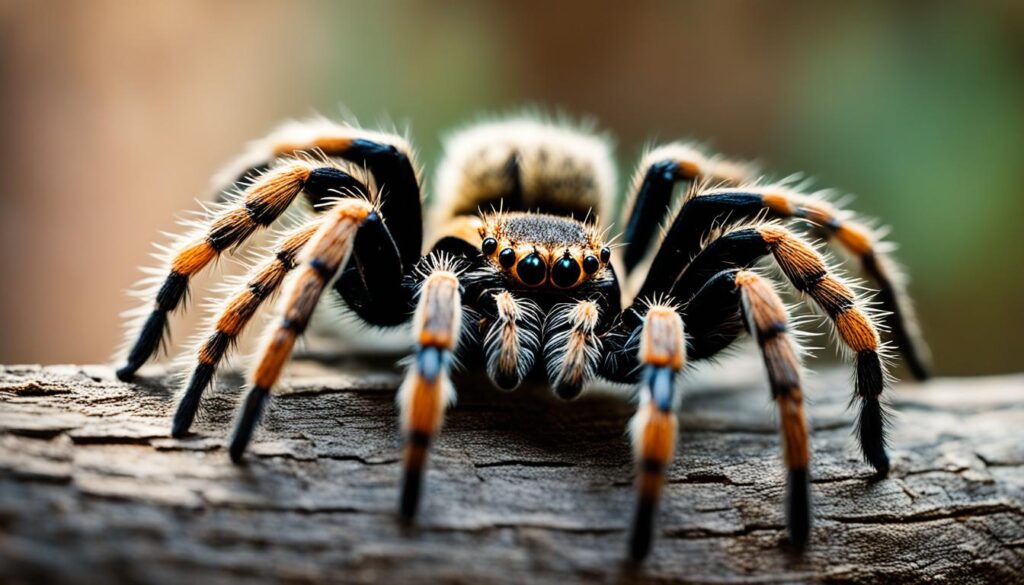
Tarpon
Tarpons are large, silver bony fish found in both saltwater and freshwater environments. They are known for their impressive size and acrobatic leaps. Tarpons belong to the order Osteichthyes, which includes all bony fish, as opposed to cartilaginous fish (Chondrichthyes) like sharks and rays.
Tarpons are divided into two species:
- Atlantic Tarpon (Megalops atlanticus)
- Indo-Pacific Tarpon (Megalops cyprinoides)
The Atlantic tarpon is found in the Atlantic Ocean, particularly along the coasts of North and South America. They can grow up to 8 feet long and weigh over 200 pounds. Atlantic tarpons are highly sought after by anglers due to their challenging nature when it comes to fishing.
Atlantic Tarpon

The Indo-Pacific tarpon is found in the Indian and Pacific Oceans, ranging from Africa to Southeast Asia. They are slightly smaller than the Atlantic tarpon, typically reaching lengths of 3 to 6 feet and weighing around 100 pounds. Indo-Pacific tarpons are also known for their strength and resilience when caught.
Indo-Pacific Tarpon
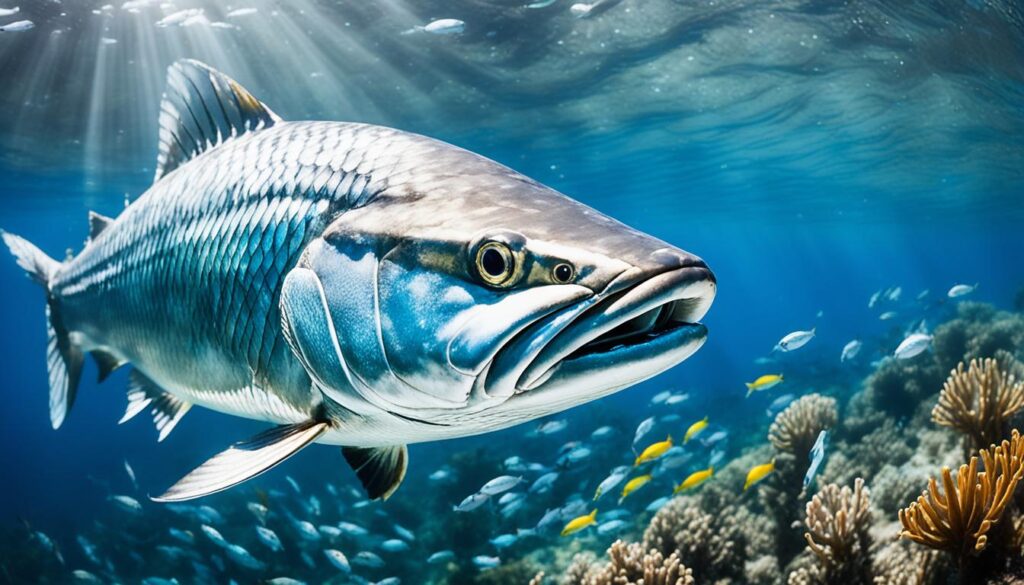
Both species of tarpon have a streamlined body covered in large, reflective scales that give them a silvery appearance. They have a unique ability to breathe air using their swim bladder, allowing them to survive in oxygen-poor areas such as stagnant water or shallow, muddy flats.
Tarpons are highly migratory, undertaking long-distance journeys in search of food and suitable breeding grounds. They primarily feed on fish, crustaceans, and occasionally, smaller tarpons. Despite their large size, tarpons have a relatively short life span, typically living up to 40 years.
| Characteristics | Atlantic Tarpon | Indo-Pacific Tarpon |
|---|---|---|
| Maximum Length | Up to 8 feet | 3 to 6 feet |
| Maximum Weight | Over 200 pounds | Around 100 pounds |
| Distribution | Atlantic Ocean, North and South America | Indian and Pacific Oceans, Africa to Southeast Asia |
These magnificent fish play an important role in the ecosystems they inhabit. As apex predators, they help regulate populations of smaller fish and maintain the balance of marine and freshwater habitats. Due to their size and sporting value, tarpons are highly valued by recreational anglers and are often caught for catch-and-release purposes.
Did you know? Tarpons have been nicknamed “silver kings” due to their spectacular silver coloration and their powerful fighting abilities.
Tarsier
Tarsiers are fascinating nocturnal primates native to Southeast Asia. With their large, soulful eyes, they capture the imagination of nature enthusiasts. These small creatures have adapted to their environment by becoming entirely carnivorous, with their diet primarily consisting of insects.
Found in countries such as Indonesia, Malaysia, and the Philippines, tarsiers are well-suited to their tropical habitat. Their large eyes provide exceptional night vision, while their sharp hearing enables them to locate and capture their prey with precision.
Despite their remarkable features, tarsiers are elusive creatures and are rarely seen by humans in the wild. They are known for their shy behavior and are skilled at blending into their surroundings, making them difficult to spot even for experienced observers.
Unfortunately, many tarsier species are currently endangered due to habitat loss and fragmentation. Deforestation and the illegal pet trade have taken a toll on their populations, making conservation efforts crucial for their survival.

By raising awareness and implementing protective measures, we can help ensure the continued existence of these captivating primates. The preservation of their natural habitat in Southeast Asia is essential to safeguard tarsiers and their unique place in the animal kingdom.
Tasmanian Devil
The Tasmanian devil, scientifically known as Sarcophilus harrisii, is the largest carnivorous marsupial. Endemic to the island of Tasmania, this unique creature has captured the attention of animal enthusiasts around the world. Despite its small size, the Tasmanian devil possesses incredible strength and an unmistakable appearance.
Known for its loud shrieks and powerful bite, the Tasmanian devil has earned its fierce reputation. It is primarily a nocturnal species, spending its nights hunting for food in the dense forests of Tasmania. With its sharp teeth and strong jaw muscles, it can easily tear through the flesh and bone of its prey.
Unfortunately, the Tasmanian devil is currently facing a significant threat. In recent years, a contagious disease called Devil Facial Tumor Disease (DFTD) has devastated the population. This contagious cancer affects the face and mouth, making it difficult for affected individuals to eat and ultimately leading to their demise. As a result, the Tasmanian devil has been classified as an endangered species.
The Tasmanian devil is known for its loud shrieks and powerful bite.
Conservation efforts are underway to save this iconic marsupial from extinction. Organizations such as the Save the Tasmanian Devil Program are working tirelessly to understand and combat the spread of DFTD. Through research, breeding programs, and public awareness campaigns, these initiatives aim to protect the Tasmanian devil and ensure its survival for future generations.
Here is a comparison of the key features and characteristics of the Tasmanian devil:
| Common Name | Scientific Name | Status | Habitat | Diet |
|---|---|---|---|---|
| Tasmanian devil | Sarcophilus harrisii | Endangered | Tasmania, Australia | Carnivorous |
As shown in the table above, the Tasmanian devil, or Sarcophilus harrisii, is currently classified as an endangered species. Its habitat is limited to the island of Tasmania, which is part of Australia. The Tasmanian devil is a carnivorous marsupial, feeding primarily on small mammals, birds, insects, and carrion.

The image above showcases the captivating appearance of the Tasmanian devil. Its stout build, dark fur, and powerful jaws are distinctive features that make it easily recognizable. The alt attribute of the image is “Tasmanian Devil”.
Tenrec
Tenrecs are fascinating small animals found on the African island of Madagascar and in some parts of the African mainland. They belong to the family Tenrecidae, which currently recognizes 34 species of tenrec. These unique creatures have varied appearances and often resemble a combination of shrews and hedgehogs.
Madagascar is a biodiversity hotspot, known for its incredible array of endemic species, and tenrecs are a prime example of this. These small mammals have adapted to different habitats across the island, resulting in a diverse range of species with specialized characteristics and behaviors.
One example of a tenrec species is the Lowland Streaked Tenrec (Hemicentetes semispinosus), which has spines on its back and exhibits fascinating behaviors such as “prickling,” where it vibrates its spines as a defensive mechanism. Another notable species is the Greater Hedgehog Tenrec (Setifer setosus), known for its ability to roll into a ball for protection.
Tenrecs play vital roles in their ecosystems. They are insectivorous, consuming a variety of invertebrates such as insects, spiders, and worms. Some species also feed on fruits and nectar, showcasing their versatility in diet.
Due to their unique evolutionary history and endemicity to Madagascar, tenrecs are of significant interest to scientists studying mammalian evolution and conservation. These animals offer valuable insights into the adaptive radiation and speciation processes that have occurred on the island.
Let’s take a closer look at three fascinating tenrec species:
- Lowland Streaked Tenrec (Hemicentetes semispinosus): This tenrec species has spines on its back and exhibits fascinating defense mechanisms.
- Greater Hedgehog Tenrec (Setifer setosus): These tenrecs are known for their ability to roll into a ball, similar to hedgehogs.
- Web-footed Tenrec (Limnogale mergulus): These tenrecs have partially webbed feet, allowing them to move easily through aquatic habitats.

Termite
Termites are fascinating insects that live in large colonies and play important roles in ecosystems. These small, pale-colored creatures are often mistaken for ants, but they have distinct characteristics that set them apart. One notable difference is their softer bodies compared to ants.
One of the most remarkable aspects of termite colonies is their longevity. Termite queens, in particular, hold the title for being the world’s longest-living insects. These queens have an impressive lifespan, with some species capable of living for several decades.
Termite colonies are highly organized and structured. They consist of different castes, each with its own specific role. The queen is the center of the colony and responsible for reproduction. She can lay thousands of eggs every day, ensuring the growth and sustainability of the colony.
The queen termite is accompanied by male drones, whose sole purpose is to mate with the queen. Additionally, there are worker termites that carry out essential tasks such as building and maintaining the nest, foraging for food, and caring for the young termites.
These complex societies of termites contribute to the decomposition of dead plant material and the recycling of nutrients in the ecosystem. However, when they invade human structures, they can cause extensive damage to wooden structures and pose a nuisance.
“Termites are industrious insects that demonstrate remarkable organization within their colonies, providing valuable ecosystem services while also being a common household pest.”
To learn more about termites, check out the table below:
| Termite Species | Distinguishing Features | Habitat |
|---|---|---|
| African Termite | Large, aggressive, dark-colored | Sub-Saharan Africa |
| Subterranean Termite | Small, pale-colored, build mud tubes | Worldwide distribution |
| Dampwood Termite | Large, pale-colored, infest damp wood | Coastal and damp regions |
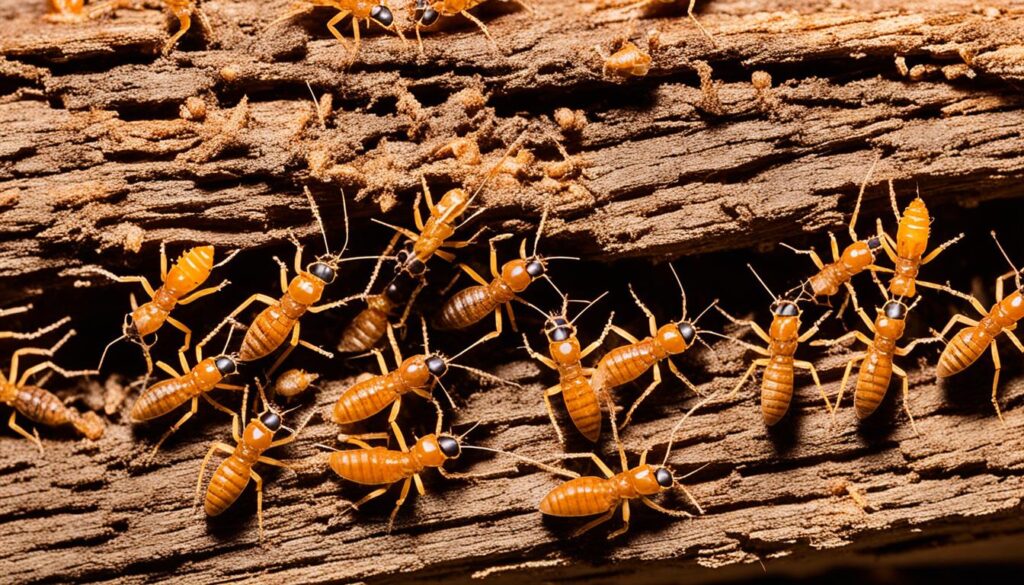
Thorny Devil
The thorny devil, also known as thorny dragon or moloch, is a lizard found in the desert and scrubland of central and Western Australia. With its unique appearance and fascinating adaptations, the thorny devil is a remarkable species of reptile.
This small lizard measures around 20 centimeters in length and features a distinctive body covered in sharp, thorn-like scales. These scales not only provide camouflage but also serve as a defense mechanism against predators. As the name suggests, the thorny devil has a thorny appearance that deters potential threats.
One of the most interesting traits of the thorny devil is its ability to collect and transport water. In the arid regions where it lives, water is scarce, but the thorny devil has evolved an ingenious solution. Its skin has grooves that help channel water droplets towards its mouth. When it encounters a rain shower or walks through dewy grass, water collects on its back and is transported to its mouth, allowing it to stay hydrated in its harsh environment.
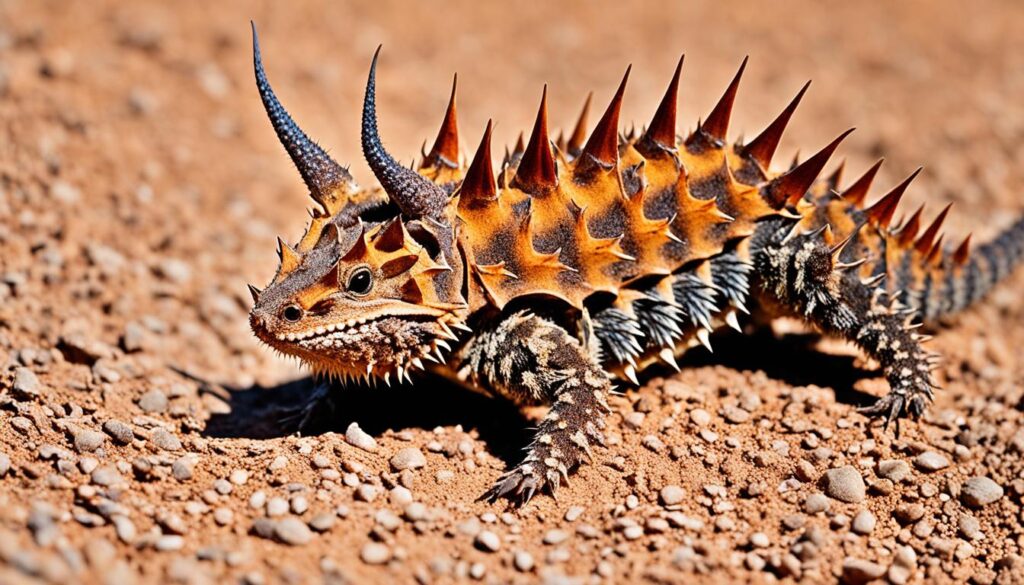
Thorny Devil Fast Facts:
| Scientific Name | Common Names | Habitat | Size | Conservation Status |
|---|---|---|---|---|
| Moloch horridus | Thorny devil, thorny dragon | Deserts and scrublands of central and Western Australia | Approximately 20 centimeters | Insufficient Data |
“The thorny devil’s scale-covered body serves as both protection and camouflage, allowing it to survive in the harsh desert conditions.” – Wildlife Expert
Tiger
Tigers, scientifically known as Panthera tigris, are the world’s largest cat species and are recognized for their striking orange coat adorned with bold black stripes. These majestic creatures are apex predators, displaying incredible strength and agility. With their powerful muscles, sharp claws, and impressive canines, tigers are capable of taking down large prey, such as buffalos.
Unfortunately, tigers are classified as endangered, facing numerous threats to their survival. It is estimated that there are fewer than 4,000 tigers left in the wild, mainly due to habitat loss, poaching, and human-wildlife conflict. To combat this critical situation, conservation efforts and stricter regulations on illegal wildlife trade are crucial for the long-term survival of this magnificent species.
Biologists and conservationists continue to study the tiger population, particularly in regards to its subspecies. There is ongoing debate and research to determine the exact number of tiger subspecies, as different regions display unique characteristics and adaptations. Protecting the genetic diversity within tiger populations is vital for their resilience in the face of future challenges.
“The tiger is a symbol of beauty, strength, and power, but its very existence hangs in the balance. It is our responsibility to protect and conserve these magnificent creatures for future generations to marvel at.”
Tiger Subspecies
The tiger is known to have several subspecies, each with its own distinct characteristics and geographical range. While the exact taxonomy remains a subject of research and discussion, currently recognized tiger subspecies include:
| Subspecies | Scientific Name | Geographical Range | Status |
|---|---|---|---|
| Bengal tiger | Panthera tigris tigris | Indian subcontinent and parts of Southeast Asia | Endangered |
| Siberian tiger | Panthera tigris altaica | Russian Far East, northeastern China | Endangered |
| Sumatran tiger | Panthera tigris sumatrae | Sumatra, Indonesia | Critically Endangered |
| Indochinese tiger | Panthera tigris corbetti | Cambodia, Laos, Myanmar, Thailand, Vietnam | Endangered |
| Malayan tiger | Panthera tigris jacksoni | Malay Peninsula | Endangered |
| South China tiger | Panthera tigris amoyensis | Southern China | Critically Endangered |
These subspecies face various threats and challenges specific to their respective habitats and ranges. Conservation efforts tailored to each subspecies are essential to ensure their survival and promote biodiversity conservation.

Tigers remain an iconic symbol in our natural world, and their conservation plays a vital role in maintaining the balance of ecosystems they inhabit. By raising awareness, supporting conservation organizations, and implementing sustainable practices, we can contribute to securing a future where tigers thrive and inspire generations to come.
Tiger Beetle
Tiger beetles, a subgroup of the Cicindelinae subfamily, are fascinating predatory insects known for their exceptional hunting abilities. With their long legs and large, curved mandibles, they are perfectly adapted for capturing their prey with incredible precision. Tiger beetles possess hardened wing cases that protect their delicate wings and enable them to swiftly chase down their targets.
These agile insects can reach remarkable speeds, capable of outrunning most of their potential predators. Their ability to rapidly accelerate and maneuver makes them exceptional hunters, allowing them to close in on their prey in a flash. The combination of their remarkable physical adaptations and lightning-fast movements has earned them the reputation of being some of the fastest running insects in the animal kingdom.
Here is an example of a tiger beetle species:
Striped Tiger Beetle (Cicindela scutellaris)
| Common Name | Scientific Name | Habitat |
|---|---|---|
| Striped Tiger Beetle | Cicindela scutellaris | Open sandy areas, grasslands, and woodland edges |
The Striped Tiger Beetle, or Cicindela scutellaris, is a common species found across North America. It can be identified by its distinct metallic appearance, green or copper-colored head and thorax, and its black and white striped wing cases. These beetles are typically found in open sandy areas, grasslands, and woodland edges where they actively hunt for small insects. With their exceptional speed and agility, they quickly capture their prey, relying on their powerful mandibles to secure a meal.
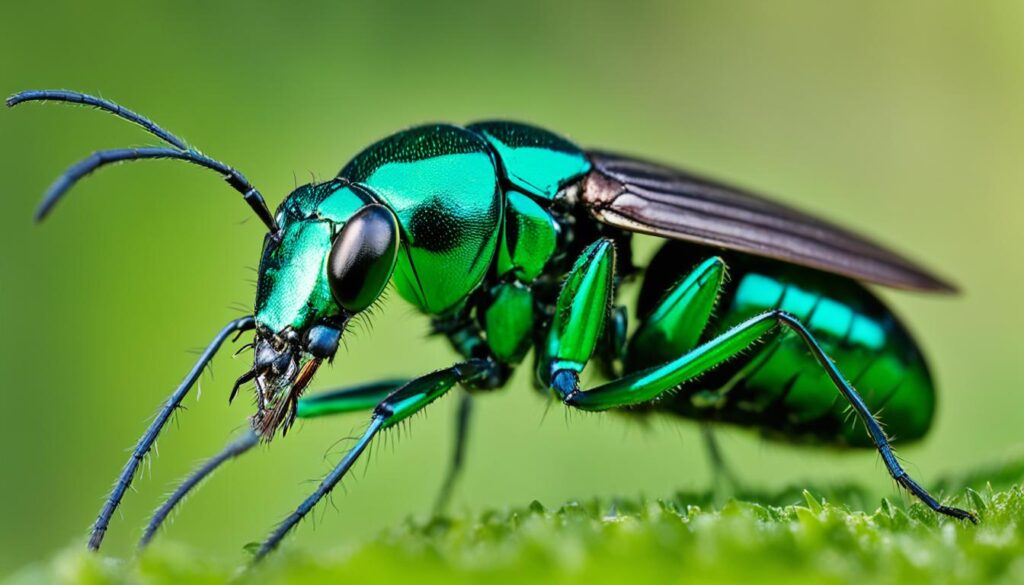
A tiger beetle showcasing its vibrant colors and distinctive appearance.
Tiger Shark
The tiger shark, scientifically known as Galeocerdo cuvier, is a large predatory fish found in tropical and subtropical waters worldwide. Its name originates from its distinctive markings, which resemble those of a tiger. With its powerful jaws and sharp teeth, the tiger shark is an apex predator capable of hunting a wide range of prey.
One striking characteristic of the tiger shark is its notorious reputation for being responsible for the second-highest number of recorded shark attacks on humans. Its aggressive nature and opportunistic feeding habits contribute to its interactions with humans in coastal areas.
Unfortunately, the tiger shark population faces threats that have led to its current status as Near Threatened. Overfishing poses a significant risk to tiger shark populations, with commercial and recreational fishing targeting them for their fins, meat, and other products.
Habitat loss is another concerning factor affecting these sharks. Coastal development, pollution, and habitat degradation disrupt their natural ecosystems and breeding grounds, further endangering their survival.
In spite of this, the tiger shark plays a crucial role in maintaining the balance of marine ecosystems. As scavengers, they help clean up the ocean by consuming carrion, and their hunting activities regulate the populations of their prey species. Protecting and conserving tiger sharks is essential not only for their own survival but also for the health and biodiversity of our oceans.

| Tiger Shark | Common Name | Scientific Name | Status |
|---|---|---|---|
| Tiger Shark | Tiger shark | Galeocerdo cuvier | Near Threatened |
Conclusion
In conclusion, the animal kingdom is filled with an incredible array of creatures, and animals that start with the letter T are no exception. From monkeys and birds to reptiles and fish, the diversity of these animals is astounding. Exploring the world of tamarins, tarantulas, tigers, and more can provide a fascinating insight into the natural world and its inhabitants.










